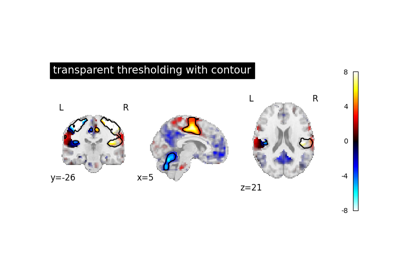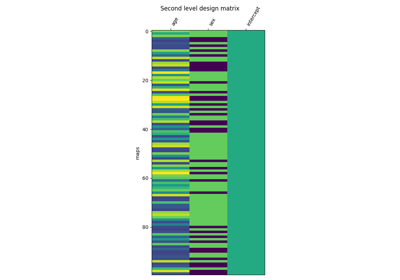Note
This page is a reference documentation. It only explains the function signature, and not how to use it. Please refer to the user guide for the big picture.
nilearn.glm.threshold_stats_img¶
- nilearn.glm.threshold_stats_img(stat_img=None, mask_img=None, alpha=0.001, threshold=None, height_control='fpr', cluster_threshold=0, two_sided=True)[source]¶
Compute the required threshold level and return the thresholded map.
- Parameters:
- stat_imgNiimg-like object, or a
SurfaceImageor None, default=None Statistical image (presumably in z scale) whenever height_control is ‘fpr’ or None, stat_img=None is acceptable. If it is ‘fdr’ or ‘bonferroni’, an error is raised if stat_img is None.
- mask_imgNiimg-like object, default=None
Mask image
- alpha
floatorlist, default=0.001 Number controlling the thresholding (either a p-value or q-value). Its actual meaning depends on the height_control parameter. This function translates alpha to a z-scale threshold.
- threshold
floatorintor None, default=None Desired threshold in z-scale. This is used only if
height_controlis None. Ifthresholdis set to None whenheight_controlis None,thresholdwill be set to 3.0.Note
When
two_sidedis True:'threshold'cannot be negative.The given value should be within the range of minimum and maximum intensity of the input image. All intensities in the interval
[-threshold, threshold]will be set to zero.When
two_sidedis False:If the threshold is negative:
It should be greater than the minimum intensity of the input data. All intensities greater than or equal to the specified threshold will be set to zero. All other intensities keep their original values.
If the threshold is positive:
It should be less than the maximum intensity of the input data. All intensities less than or equal to the specified threshold will be set to zero. All other intensities keep their original values.
- height_control
str, or None, default=’fpr’ False positive control meaning of cluster forming threshold: None|’fpr’|’fdr’|’bonferroni’
- cluster_threshold
int, default=0 Cluster size threshold. Sets of connected voxels / vertices (clusters) with size smaller than this number will be removed.
- cluster_threshold
- two_sided
bool, default=True Whether the thresholding should yield both positive and negative part of the maps. In that case, alpha is corrected by a factor of 2.
- stat_imgNiimg-like object, or a
- Returns:
- thresholded_mapNifti1Image,
The stat_map thresholded at the prescribed voxel- and cluster-level.
- threshold
float The voxel-level threshold used actually.
See also
nilearn.image.threshold_imgApply an explicit voxel-level (and optionally cluster-level) threshold without correction.
Notes
If the input image is not z-scaled (i.e. some z-transformed statistic) the computed threshold is not rigorous and likely meaningless
Examples using nilearn.glm.threshold_stats_img¶

Intro to GLM Analysis: a single-run, single-subject fMRI dataset



